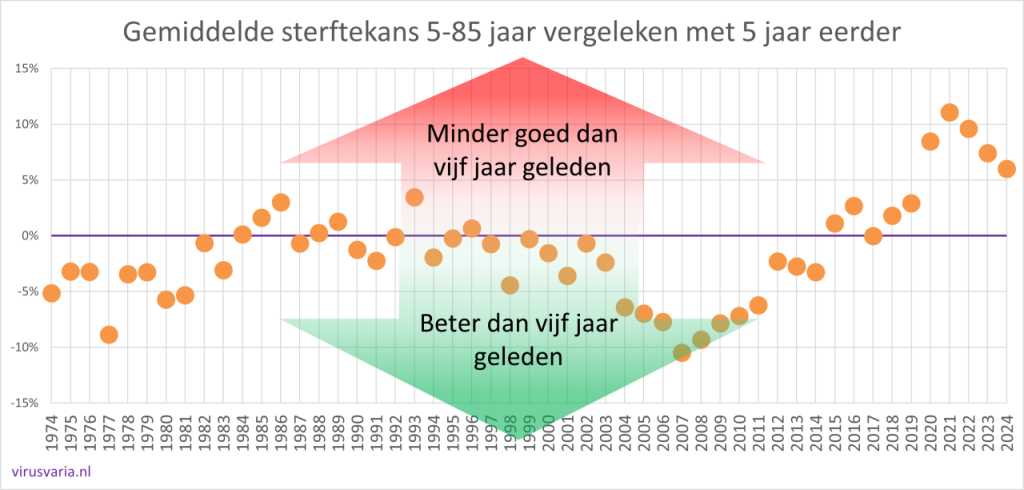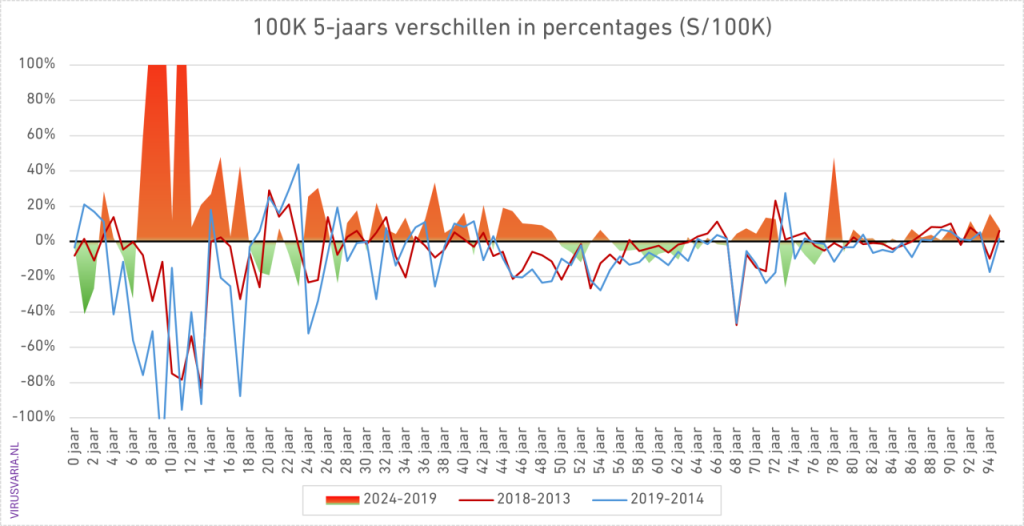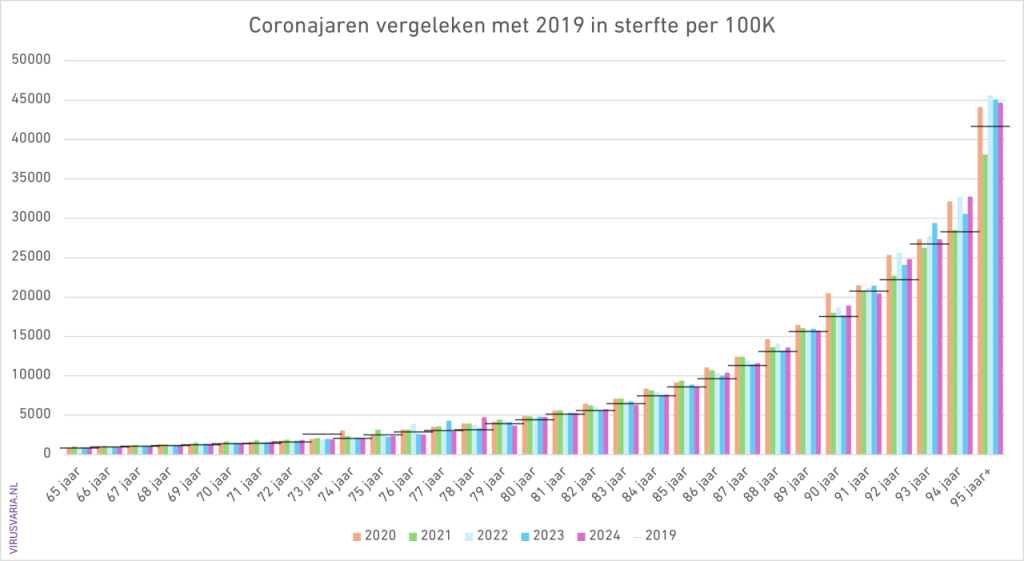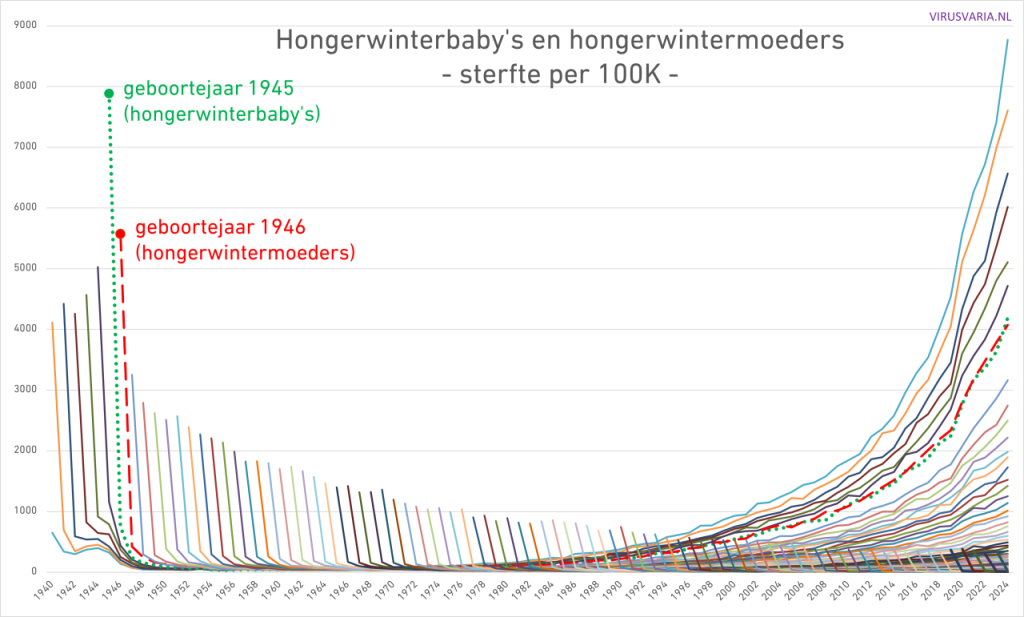CBS is in trouble: still too many deaths. They mention âdelay in recoveryâ (read: persistent excess mortality) but have no idea where that delay comes from. Yet they see reason to assume that we will not return to the trend before the corona pandemic. That sounds defeatist. Never again...!? Even I don't believe that! Then something very drastic has changed, something that is passed on genetically or something.
A nice item for the Sinterklaas news!
CBS's proposal is now a matter of sand. They now equate their forecasts to approximately those of the RIVM, while RIVM has indicated that their forecasts are only intended to identify incidental events such as flu and heat waves. We have explained this in detail in Excess mortality among 40 year olds on Herman Steigstra's site1Herman Steigstra: Excess mortality among 40 year olds. That article focuses in particular on the cohort of women aged 40-50, about which Hans Verwaart has previously written.2Hans Verwaart: Causes of death behind the excess of women between 40 and 50 years old. There are other points of interest to point out.
If you are curious about what CBS calls âdelay in recoveryâ, read the drop-down âfree to CBSâ. It is virtually the original CBS text. I just added a few elements that they had forgotten.
Free to CBS
Direct and indirect effects of the corona pandemic on mortality are diverse. On the positive side, what may reduce mortality are the 'healthy survivor effect' (unhealthy people are more likely to die from COVID-19, leaving you with an average healthier population) and healthier habits (less smoking) and less polluted air. In addition, lessons learned in the field of public health, new medical technologies such as mRNA vaccines approved under emergency conditions and perhaps more money for health and social security in the long term, could increase or decrease mortality respectively. It is clear that treatment methods and medicines related to COVID-19 have improved since the start of the pandemic and it has also been proven that the vaccines are effective in certain cases (RIVM, 2021; CBS and RIVM, 2022), even though some improvements with unknown long-term effects do not completely rule out future increases in mortality. Since the omikron variant, the severity of the disease has also decreased.
What could lead to higher mortality is that people who were already old or sick, have experienced corona or experienced side effects from interventions, experience a decline in health, now or in the future. Although this has never been observed before after a pandemic, the possibility should not be ruled out. Much is still unclear about the role of risk factors, vaccinations and comorbidity (having one or more conditions) in relation to mortality from COVID-19 and other causes. New waves of infections and/or new variants may emerge. In addition, much is still unknown about effects on mortality that are not directly but indirectly caused by the virus, such as vaccinations against the virus, treatments and doctor visits postponed due to the virus and the economic situation that has suffered from the measures against the virus.
In the previous forecasts, due to the uncertainty about the further impact on mortality due to COVID-19, measures and emergency vaccinations, the assumption was made that there would be no lasting effect on life expectancy in the long term. This assumption followed previous research showing that it is likely that the upward trend in life expectancy will not be adversely affected in the longer term (Stoeldraijer, 2020b; Royal Actuarial Society, July 5, 2021; Schöley et al., 2022). After previous periods of high mortality, such as the Spanish flu and the Second World War, life expectancy quickly returned to its previous level. Subsequently, the trend before the period with high mortality continued.
Now that the WHO has indicated that the emergency is over and that COVID-19 is now well established and remains persistently mild and because the vaccinations cannot be reversed, the situation in 2023 does provide some insight into the future effect of the corona period on mortality. Recovery is visible and further progress is still possible, but it is slower than expected. For that reason, a complete recovery to the trend before the corona pandemic is no longer assumed CBS
The Royal Actuarial Society, on the other hand, does know where the excess mortality comes from: from Covid 3Royal Actuarial Society still sees excess mortality due to Covid. So they are out. They had initially estimated that excess mortality would decrease by 50% per year, but they have now only reduced that to 25%, which is closer to the observations so far. Nice round numbers, adjusted to the abrupt increase.
They just leave it at that. Which is a shame because turning numbers inside out sometimes produces an unexpected gem. I'll list a few of them below.
Comparisons with 5 years earlier
The comparison of 2024 with 2019 was an educational exercise4Comparison 2024-2019: https://virusvaria.nl/2024-en-2019-vergeleken-in-leeftijdscohorten-m-v/. You compare a year with 5 years earlier and see what the mortality rates are like. There is quite a bit of arbitrariness in that, but 2019 was the last pre-corona year, 2024 the most recent year, so let's move on. In that article I already indicated how such a comparison works out if you compare 2019 with 2014, or 2018 with five years earlier: 2013. In both cases, the 2024-2019 comparison is dismal.
But how much does that say? Hasn't that happened much more often, for example in the past 50 years? We compare every year with five years before. More mortality than 5 years ago is above the 0% line.

Of the fifty comparable measurements, fourteen scored worse than five years earlier. The worst five are 2020 to 2024. 2024 is clearly one of the years with the largest setback. Worse than 2019. In fact, 2024 had a bigger decline than all the years before 2020!
Children: don't be scared!
You can see more through a microscope than through binoculars. Or vice versa â because it just depends on what you want to see. We always look at trends and try to identify major movements over long periods of time involving tens of millions of people. But zooming in on 1-year cohorts, as in that earlier article, reveals other interesting phenomena.
Perhaps an even more exciting item for the Sinterklaas news!
For example, the peaks in children from 7 years to 17 years old look dramatic below, especially in view of the red and blue lines, which show the same comparisons of pre-corona years.

The reassuring message I would give if I worked at CBS: the absolute numbers are particularly small in children, which increases the uncertainty many times over. These figures should be interpreted with great caution.
I would not include the table below in public communication. And certainly not to mention that that age group has shrunk by about 3% compared to 2019...
| Age | Deaths (absolute numbers) | Difference 2024-2019 | % tov 2019 | |
|---|---|---|---|---|
| 2019 | 2024 | |||
| 7 years | 9 | 14 | 5 | +56% |
| 8 years | 8 | 18 | 10 | +125% |
| 9 years | 7 | 18 | 11 | +157% |
| 10 years | 14 | 15 | 1 | +7% |
| 11 years | 9 | 26 | 17 | +189% |
| 12 years | 12 | 13 | 1 | +8% |
| 13 years | 13 | 16 | 3 | +23% |
| 14 years | 19 | 24 | 5 | +26% |
| 15 years | 21 | 30 | 9 | +43% |
| 16 years | 31 | 30 | -1 | -3% |
| 17 years | 25 | 34 | 9 | +36% |
| Total: | 168 | 238 | 70 | 41,7% |
But OK âYou have to remember: this is of course only 70 more children who died than in 2019, so the total mortality is not that badâ⊠đą
Baby boomers: don't be alarmed either

The observant chart analyst has already seen it in the previous article: in 2019, 73-year-olds had a bad year. Look at the line for 73-year-olds in the graph above (2019 is the line). These are the same people as the 74 year olds in 2020, 75 in 2021 etc. (78 in 2024). Their rod squeaks everywhere. A double check with HMD (Human Mortality Database): exactly the same.
That peak has played tricks on us before, see this cohort graph 70-79. At 73, the bars should also turn dark because the 2019 standard (the line) is unattainably high due to the TSR-1946, which was 73 years old in 2019. The 78 bar (the same group as the 73 line, but 5 years later in 2024), on the other hand, is enormous. The 2019 line fits neatly into the trend. On balance, it doesn't matter in the 10-year cohort. Do we still get it?
Demographers already know where this is going, but we never really hear anything about it other than general terms like âagingâ and âbaby boom generationâ. Now âgenerationâ is a big word for 1 year of birth. It is mainly about 1946: that was not a good year. For those who think this explains the excess mortality: it makes a difference of 0.2% on total mortality, and has been pushing back mortality rates since 1980. So this blip is also no explanation for the trend break in 2021.

For readability, I have not shown all ages. The blue marker indicates mortality in WWII. This was immediately followed by a baby boom in 1946 and, albeit much less, in 1947. The yellow marker indicates the death rates of the WWII baby boomers. In those 1946 people we see an abnormal, increased mortality per 100K, at every age.
Travelling Survival Rates â I thought it was a nice term. That mortality peak travels with the cohort over time. There is also literature about it, but I have not come across it as clearly as in this graph.
Starving winter mothers and their babies
The graph below actually speaks for itself. The upright bars are the zero-year deaths, which is certainly getting better. The year of birth of 1945 shows that the Hunger Winter killed many babies (there is also literature about that). In 1946, many babies were born to malnourished mothers in the Western Netherlands, which is the ripple effect we saw in the Traveling Survival Rates. While in all other cohorts the relative mortality is in order of age generation of 1946 had higher mortality rates than the one year older generation of 1945. This cannot be reversed and is therefore not something to worry about. The effect is astonishingly strong and speaks for itself. I can only add that here we see one of the horrors of war. And to think how some politicians enthusiastically push for it.

Perhaps this is also what people think about vaccinations: Just keep that out of the publicity because what happened happened and there is nothing you can do about it.
Because what we see below has not been normal since 2021.
Will these also be vintages that will make a ripple?
References
- 1Herman Steigstra: Excess mortality among 40 year olds
- 2
- 3Royal Actuarial Society still sees excess mortality due to Covid
- 4Comparison 2024-2019: https://virusvaria.nl/2024-en-2019-vergeleken-in-leeftijdscohorten-m-v/
- 5
- 6





That first graph, with a comparison between 5 years ago, is interesting. I'd like to see this without the people who are quite vulnerable to the flu. Anton, can you adjust this graph to 5-75 quite easily?
Greetings Bonne
Eens. Tevens bij mij de vraag of dit voor alle overlijdens geldt of per 100.000.
Groet Hans